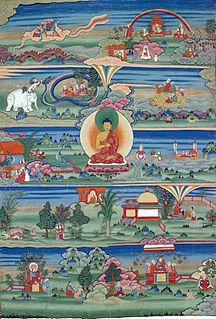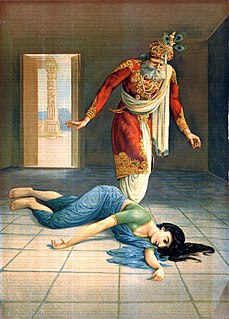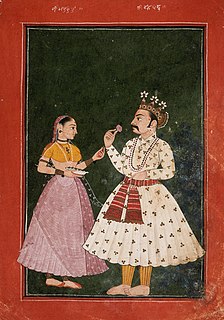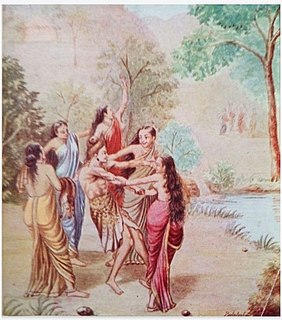Related Research Articles

Ashoka, known by his Greek name Piodasses, also known as Ashoka the Great, was an Indian emperor of the Maurya Dynasty, who ruled almost all of the Indian subcontinent from c. 268 to 232 BCE. A grandson of the Maurya dynasty's founder Chandragupta Maurya, Ashoka promoted the spread of Buddhism across ancient Asia. Considered by many to be one of India's greatest emperors, Ashoka expanded Chandragupta's empire to reign over a realm stretching from present-day Afghanistan in the west to Bangladesh in the east. It covered the entire Indian subcontinent except for parts of present-day Tamil Nadu, Karnataka, and Kerala. The empire's capital was Pataliputra, with provincial capitals at Taxila and Ujjain.

The Jataka tales are a voluminous body of literature native to India concerning the previous births of Gautama Buddha in both human and animal form. The future Buddha may appear as a king, an outcast, a god, an elephant—but, in whatever form, he exhibits some virtue that the tale thereby inculcates. Often, Jātaka tales include an extensive cast of characters who interact and get into various kinds of trouble - whereupon the Buddha character intervenes to resolve all the problems and bring about a happy ending.

Kaikeyi was the second consort of King Dasharatha and the Queen of Ayodhya in the Hindu epic, the Ramayana. Out of Dashrath's three wives, Kaikeyi had the most significant role. She was the princess of Kekeya and a powerful warrior, who helped her husband during a war. Kaikeyi was a mother of Bharata. Initially loving and motherly towards her stepson, Rama, Kaikeyi's mind was poisoned by Manthara, her maid. Under her influence, Kaikeyi sent Ram to the forest.
Itihasa refers to the collection of written descriptions of important events in Hinduism. It includes the Mahabharata, the Puranas and the Ramayana. The Mahabharata includes the story of the Kurukshetra War and preserves the traditions of the Lunar dynasty in the form of embedded tales. The Puranas narrate universal history as perceived by Hindus – the books discuss in depth the topics of cosmogony, myth, legend and history. The Ramayana contains the story of Rama and is incidentally related to the legends of the Solar dynasty. A story is considered to be itihasa only when the author of the story has himself witnessed or is part of the story. Vyasa, who wrote the Mahabharata, is himself a character in the story. Similarly, Valmiki, who wrote the Ramayana, was also a character in the story. Many classical Indian poets derive the plots of their poetry and drama from the Itihasa.

The Ramakien is one of Thailand's national epics, derived from the Buddhist Dasaratha Jataka. Ramakien is an important part of the Thai literary canon.

In the Hindu epic Mahabharata, Pandu was a king of Kuru Kingdom. He is regarded as the "father" of the five Pandava brothers, though they were actually gifted by different gods due to his inability of having children following Maharisi Kindam's curse.

Rishyashringa is a Rishi mentioned in Indian scriptures from the late first millennium BCE. According to the Hindu epics Ramayana and Mahabharata, he was a boy born with the horns of a deer who became a seer and was lured by royal courtesans, which led to the yajna of King Dasharatha. He also occurs in the Buddhist Jatakas, where he is mentioned as the son of Bodhisatta and was tried to seduce by royal or divine courtesans.

"The Golden Goose" is a fairy tale collected by the Brothers Grimm. It is a tale of Aarne-Thompson type 571, with an episode of type 513B.

Vatsa or Vamsa was one of the sixteen Mahajanapadas of Uttarapatha of ancient India mentioned in the Anguttara Nikaya. Vatsa or Vamsa country corresponded with the territory of modern Allahabad in Uttar Pradesh, at the confluence of the Ganges and Yamuna rivers.

Prince Vijaya was the traditional first Sinhalese king as written in the Sri Lankan chronicle the Mahāvaṃsa. His reign is traditionally dated to 543–505 BCE. Vijaya was a prince of Sinhapura tracing descent from the Vanga Kingdom in present day Bengal. Legends say he and several hundred of his followers came to Sri Lanka after being expelled from his home. According to the Mahavamsa, when in Sri Lanka, Vijaya and his settlers defeated a Yakkha colony near to "Thammena"(Tambapaṇṇī) and displaced the island's previous inhabitants, from their city of "Sirisavatthu" with the support of their Princess Kuveni, establishing a new kingdom called the Kingdom of Tambapanni and becaming the ancestors of the modern Sinhalese people.
Danda is a frequently featured region in Hindu mythology, as in Dandaka, a kingdom and a forest bearing the same name. It was a colonial state of Lanka under the reign of Ravana. Ravana's governor Khara ruled this province. It was the stronghold of all the Rakshasa tribes living in the Dandaka Forest. It is roughly the Nashik District, Maharashtra with Janasthana as its capital. It was from here that the Rakshasa Khara attacked Raghava Rama of Kosala, who lived with his wife and brother at Panchavati, not far away.
Kshanti or khanti (Pāli) is patience, forbearance and forgiveness. It is one of the pāramitās in both Theravāda and Mahāyāna Buddhism.

The Kingdom of Dambadeniya was a medieval kingdom in what is present day Sri Lanka. The kingdom's rulers reigned from 1220–1345.

The Vessantara Jātaka is one of the most popular jātakas of Theravada Buddhism. The Vessantara Jātaka tells the story of one of Gautama Buddha's past lives, about a very compassionate and generous prince, Vessantara, who gives away everything he owns, including his children, thereby displaying the virtue of perfect generosity. It is also known as the Great Birth Sermon.
King Kalābu, also known as King Kalinga, King Kalabha or King Kali is a mythical king in Buddhism. His name is extant in both Southern Buddhism and Northern Buddhism. In Chinese he is known as 歌利王, sometimes rendered 迦蓝浮王 or 卡拉補王.
The Mahanipata Jataka, sometimes translated as the Ten Great Birth Stories of the Buddha, are a set of stories from the Jataka tales describing the ten final lives of the Bodisattva who would finally be born as Siddharta Gautama and eventually become Gautama Buddha. These jataka tales revolve around Benares, the current Varanasi in India. The final ten are the best known of the total 547 jataka tales. In Cambodia and Thailand, they are known as ទសជាតក and ทศชาติชาดก, respectively. These render the 10 virtues of mankind, that the enlightenment would reveal. These respective virtues are: renunciation, vigour, benevolence, absolute determination, insight, morality, patience, equanimity, reality and generosity.
Avakinnayo Karakandu or Karakanda was a powerful legendary Jain emperor of Kalinga, who is said to have lived in around 9th century BCE.
Kalinga II was a powerful monarch and possibly an emperor from around the speculated era towards the end of 7th century BCE. He was the son of Chullakalinga, the youngest son of Kalinga I who had married a virtuous princess from Sagala (Madra). Kalinga II ascended the throne of the ancient state of Kalinga after the death of his paternal uncle Mahakalinga. Kalinga II finds mention in early Buddhist Jataka records of Chullakalinga Jataka and Kalingabodhi Jataka. He had spent most of his young life in the forests of Himavat where his father lived in exile. Trained with qualities of a king by his father and maternal grandfather, he was asked by Chullakalinga to go back to take the charge of his ancestral kingdom.
Medhaṅkara Buddha is the second of the twenty-seven buddhas who preceded the historical Gotama Buddha.He was also the second Buddha of the Sāramaṇḍa kalpa.
References
- ↑ "The Jataka, Vol. IV, tr. by W.H.D. Rouse, [1901], at sacred-texts.com". www.sacred-texts.com. Retrieved 7 July 2017.
- ↑ "Classical Odia" (PDF). Retrieved 7 July 2017.
- ↑ Jataka Tales 1916. Delhi: Gyan Books Pvt. Ltd. (Delhi, India). 1916. pp. 343–345. ISBN 9333377263.
- ↑ "Kālingabodhi Jātaka". www.what-buddha-said.net. Archived from the original on 6 August 2014. Retrieved 7 July 2017.